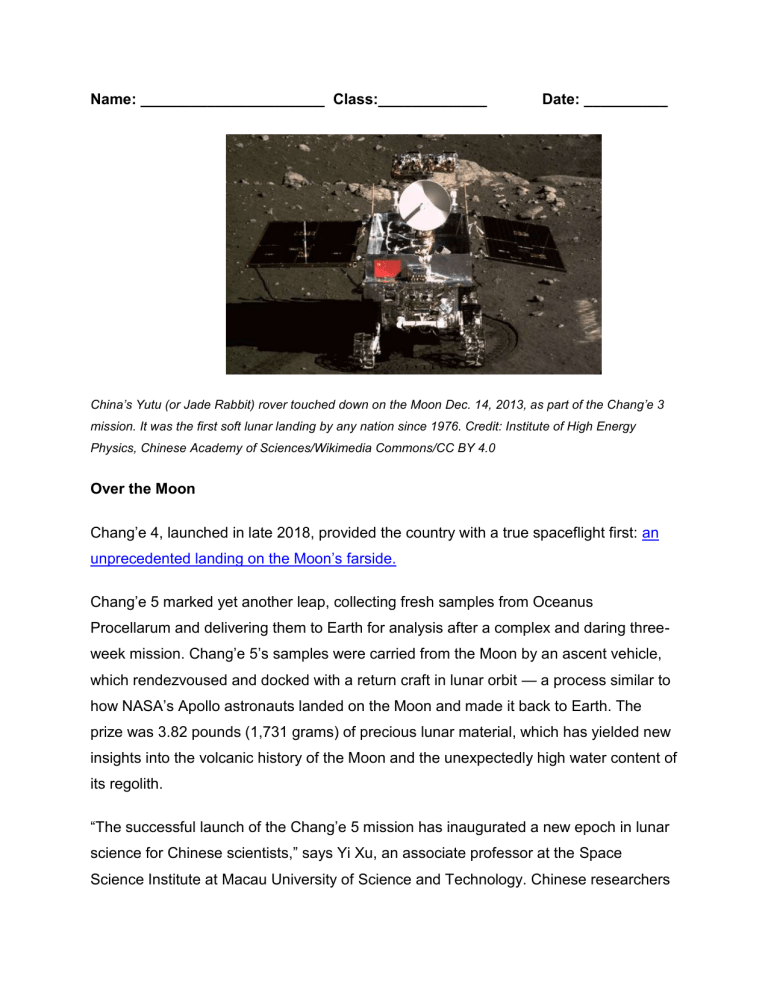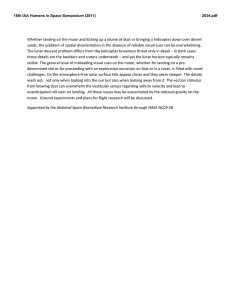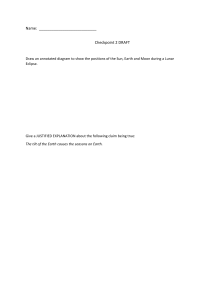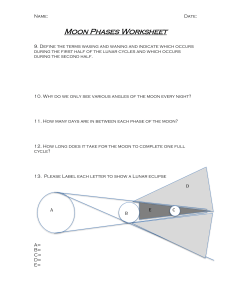
Name: ______________________ Class:_____________ Date: __________ China’s Yutu (or Jade Rabbit) rover touched down on the Moon Dec. 14, 2013, as part of the Chang’e 3 mission. It was the first soft lunar landing by any nation since 1976. Credit: Institute of High Energy Physics, Chinese Academy of Sciences/Wikimedia Commons/CC BY 4.0 Over the Moon Chang’e 4, launched in late 2018, provided the country with a true spaceflight first: an unprecedented landing on the Moon’s farside. Chang’e 5 marked yet another leap, collecting fresh samples from Oceanus Procellarum and delivering them to Earth for analysis after a complex and daring threeweek mission. Chang’e 5’s samples were carried from the Moon by an ascent vehicle, which rendezvoused and docked with a return craft in lunar orbit — a process similar to how NASA’s Apollo astronauts landed on the Moon and made it back to Earth. The prize was 3.82 pounds (1,731 grams) of precious lunar material, which has yielded new insights into the volcanic history of the Moon and the unexpectedly high water content of its regolith. “The successful launch of the Chang’e 5 mission has inaugurated a new epoch in lunar science for Chinese scientists,” says Yi Xu, an associate professor at the Space Science Institute at Macau University of Science and Technology. Chinese researchers “can now delve into the dating, mineralogy, chemical composition, microscopic features, and more, of lunar samples.” Another major milestone, one previously achieved only by NASA, was the May 2021 landing of the Zhurong rover on the martian surface as part of the Tianwen 1 mission, which also featured an orbiter. Zhurong successfully completed 347 martian days of exploration before going into hibernation in May 2022. Although the rover never woke up, it exceeded its 90-day intended lifespan several times over. Zhurong has greatly encouraged researchers in the field of martian science and wider planetary sciences in China, according to Xu. One of its major discoveries is that water may have existed on the surface of its landing site in the recent past — evidence that could not have been detected by remote sensing from orbit. These missions are not just technology demonstrations. The scientific data they have returned are also providing new opportunities and helping to build interest and expertise. “They’re developing a community, and the community is really excited,” says James Head III, a planetary scientist at Brown University in Providence, Rhode Island. “The China National Space Administration is also doing a really good job and building the community towards engineering interactions that are only going to strengthen the program further.” Aiming higher These flights also served as a test run for more complex missions — including two of the most challenging endeavors for any major space power. First, China aims to put astronauts on the Moon before the end of this decade. The nation’s human spaceflight agency formally announced this goal on May 29, 2023, just one day before it inaugurated its Tiangong space station with the launch of its first crew. It is a timeline that China has a good chance of achieving, based on its progress in rocketry, crewed spaceflight, and robotic lunar missions. The country’s main space contractor, China Aerospace Science and Technology Corporation (or CASC), is developing a new rocket, the Long March 10, capable of putting 27 tons into lunar orbit. A pair of these rockets will send a crewed spacecraft (which has already flown in a highorbit test) and a lander stack to the Moon; these will rendezvous in lunar orbit. A lunar lander, a rover (possibly commercially developed), and a lunar space suit are all in the works. The landing wouldn’t be a mere flags-and-footprints mission, but fit into a wider plan known as the International Lunar Research Station. For this, China envisions constructing a permanent, initially robotic base on the Moon using five launches of a super-heavy-lift rocket named Long March 9. Later, crews will be sent to inhabit the lunar outpost. The country is currently seeking international partners for the megaproject, which will happen alongside NASA’s Artemis program to return astronauts to the Moon. Depending on funding, technical hurdles, and other variables, this could develop into a geopolitically tense race to see who gets boots back on the Moon first. The other related project is the current holy grail of Mars science: a Mars sample-return mission. Bringing pieces of the Red Planet back to Earth for analysis in laboratories will reveal much more about the planet’s history — and potential ancient life — than can be gleaned from robotic rovers. The Tianwen 3 mission will be China’s effort to collect and retrieve martian samples, currently scheduled to lift off around 2030 with the help of two Long March 5 rockets. Collecting samples from Mars will be more challenging than from the Moon. The much greater distance and time delay require greater automation, and adjustments will need to be made for Mars’ gravity. Launching a two-stage rocket from inside the martian atmosphere is a different proposition than a single-stage launch from the airless Moon. But if China meets these challenges, it could beat NASA’s efforts. NASA has a head start — its Perseverance rover has already cached dozens of samples and left them on the ground. However, the mission to retrieve them is facing budgetary headwinds. On the science side, the plans and objectives are beginning to take shape. Head attended a conference in Hefei, Anhui province, in 2023, held as part of China’s annual national space day — April 24, the anniversary of the country’s first orbital launch in 1970. The Tianwen 3 sessions drilled down into the engineering constraints and geological criteria for landing, he says. According to Head, researchers have compiled a preliminary list of 86 sites with potential astrobiological and geological value. The meeting also discussed the main science objectives — including searching for signs of life — and issues such as handling the samples once on Earth. Technologically, the mission builds on accomplishments demonstrated by Chang’e 5: robotic sampling, deep-space rendezvous and docking, and launching a return vehicle from the surface of another world. Tianwen 1 also provides valuable reference information for the future martian sample-return mission; the Zhurong rover tested China’s ability to perform entry, descent, and landing onto the martian surface. Answer the following questions in your notebook. 1. What significant achievement did Chang’e 4 accomplish in late 2018? 2. Explain the process by which Chang’e 5 collected lunar samples and brought them back to Earth. 3. Describe the major milestone achieved by Zhurong rover as part of the Tianwen 1 mission. 4. How did Zhurong contribute to the field of martian science according to the passage? 5. What is the International Lunar Research Station, and how does China plan to contribute to it? 6. What are the two challenging endeavors that China aims to achieve in the near future, as mentioned in the passage? 7. Briefly outline China's plan for landing astronauts on the Moon before the end of the decade. 8. What is the significance of constructing a permanent base on the Moon as part of the International Lunar Research Station? 9. Describe the challenges involved in collecting samples from Mars, as explained in the passage. 10. How does the Tianwen 3 mission build on the accomplishments demonstrated by Chang’e 5, and what valuable information did Tianwen 1 provide for future martian sample-return missions?



